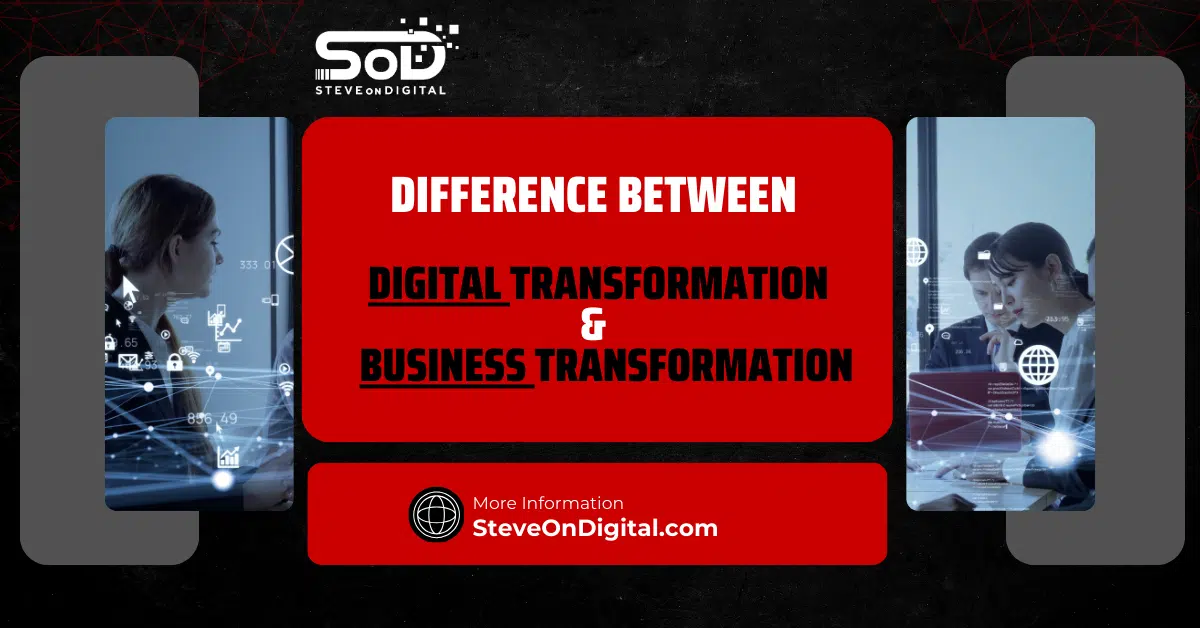When embarking on a digital transformation journey, ask these essential questions: Do we need a cybersecurity maturity assessment? Are we hitting key performance indicators (KPIs) and expected ROI? Are our projects aligned with business objectives? Is our investment in digital transformation strategic and effective?
Digital transformation integrates technology into all areas of a business, changing operations and delivering value to customers. It’s about cultural change, continuous improvement, and leveraging new technologies to drive growth, improve efficiency, and enhance customer experiences. Companies deploying digital solutions must conduct a thorough assessment of current operations, develop a comprehensive digital strategy, make significant investments in technology and training, and adopt agile work practices to ensure effective implementation. Understanding these questions can help ensure a successful transformation journey.
I’m Steve, a digital transformation expert with a strong background in electrical engineering, an MBA, and a master’s in Project Management. I excel at helping SMEs navigate the digital landscape with practical insights. Let’s begin!
Key Questions for Digital Transformation
To guide you through this complex process, here are some essential digital transformation questions to consider:
Do We Need a Cybersecurity Maturity Assessment?
In today’s digital landscape, cybersecurity is paramount. With increasing cyber threats, businesses must prioritize protecting their data and systems. A cybersecurity maturity assessment evaluates your current security practices and identifies vulnerabilities. This proactive approach helps build a strong foundation of security, safeguarding your business from potential disruptions.
Importance of Cybersecurity
Cybersecurity is vital as data breaches can cost companies millions. For example, IBM reported that the average cost of a data breach in 2023 was $4.24 million. Ensuring your business is secure not only protects against financial loss but also builds trust with customers.
Components of a Cybersecurity Maturity Assessment
A thorough assessment includes evaluating your IT infrastructure, security policies, and compliance with regulations. It helps identify gaps and areas for improvement.
Steps to Conduct an Assessment
- Initial Review: Assess current security measures.
- Gap Analysis: Identify vulnerabilities and non-compliance areas.
- Implementation Plan: Develop a plan to address identified gaps.
Are We Hitting Key Performance Indicators (KPIs) and Expected ROI?
Measuring the success and return on investment (ROI) of digital transformation initiatives is crucial. Regularly evaluate whether you are hitting KPIs and achieving the expected ROI.
Identifying Relevant KPIs
KPIs might include metrics like customer satisfaction scores, operational efficiency, and revenue growth. According to McKinsey, companies that successfully leverage digital tools see a 20-30% increase in financial performance.
| KPI Metric | Description |
| Customer Satisfaction | Measures customer happiness (e.g., NPS score) |
| Operational Efficiency | Tracks productivity improvements |
| Revenue Growth | Monitors increase in sales and profit |
| Digital Adoption Rate | Measures how quickly new tech is adopted |
| Employee Productivity | Tracks improvements in employee output |
Tracking and Measuring ROI
Use data analytics tools to track performance against KPIs. Adjust strategies based on this data to ensure continuous improvement.
Adjusting Strategies Based on Metrics
Regularly review performance data to make informed decisions. If a strategy isn’t delivering the desired ROI, be prepared to pivot.
Are Our Projects Aligned with Business Objectives?
Digital transformation projects must support overall business goals, considering their challenges and best practices. Regularly reassess whether your digital transformation project aligns with your strategic objectives to evaluate its potential success and challenges.
Aligning Digital Initiatives with Strategic Objectives
Ensure that each digital project supports your long-term business goals. For example, if customer experience is a priority, focus on technologies that enhance this aspect.
Regular Review and Adjustment of Projects
Periodically review projects to ensure they remain aligned with business objectives. Adjust as necessary based on performance data.
Importance of Stakeholder Involvement
Involve key stakeholders in planning and reviewing digital projects. This ensures alignment with business goals and secures necessary buy-in for successful implementation.
Is Our Investment in Digital Transformation Strategic and Effective?
Evaluating the financial aspects of digital transformation is essential. Understanding where your investments are going and their impact on your overall strategy helps in making informed decisions. Developing key digital transformation strategies aligned with business objectives ensures that your investments are strategically placed to foster innovation and adaptability.
Budget Allocation and Monitoring
Track your spending on digital initiatives. Ensure resources are allocated efficiently to projects that align with your strategic goals.
Assessing Cost-Effectiveness
Evaluate the cost-effectiveness of your investments. According to Deloitte, companies with advanced digital maturity report 45% revenue growth, compared to 15% for lower maturity firms.
Making Informed Investment Decisions
Use data and insights to guide investment decisions. Focus on technologies that offer the highest return on investment and align with your business objectives.
Digital Transformation Strategies
Crafting a comprehensive strategy tailored to business needs is critical for successful digital transformation.
Digital transformation interview questions can be essential in assessing candidates’ knowledge and adaptability regarding digital change.
Developing a Digital Transformation Strategy
A well-developed strategy involves setting clear objectives and involving key stakeholders in the planning process.
Steps to Develop a Strategy
- Assessment: Evaluate current digital capabilities and identify gaps.
- Goal Setting: Define clear, measurable objectives.
- Planning: Develop a roadmap for implementation, including timelines and resource allocation.
Involving Key Stakeholders
Engage stakeholders from across the organization to ensure the strategy aligns with overall business goals and has the necessary support for implementation.
Setting Clear Objectives and Milestones
Establish specific goals and milestones to track progress and ensure the strategy remains on track.
Implementing Digital Transformation
Executing digital transformation plans involves several phases and requires careful management to overcome challenges.
Phases of Implementation
- Pilot Projects: Start with small-scale projects to test and refine strategies.
- Scale-Up: Expand successful projects across the organization.
- Optimization: Continuously improve and optimize digital processes.
Role of Change Management
Effective change management is critical. It involves preparing employees for new technologies and processes, managing resistance, and ensuring a smooth transition.
Overcoming Implementation Challenges
Common obstacles include adapting to change, a shortage of skilled personnel, and various technical challenges. Address these proactively with training programs, clear communication, and robust technical support.
Digital Transformation Initiatives
Digital Solutions for Business Processes
Digital transformation involves implementing various digital tools to enhance business processes. These tools can help streamline operations, improve efficiency, and drive growth.
Enterprise Resource Planning (ERP) Systems
ERP systems integrate core business processes, including finance, HR, and supply chain, into a single system. This integration allows for better data visibility and improved decision-making. According to Statista, the global ERP software market is expected to reach $49.5 billion by 2024. My experience with ERP implementation shows that it significantly reduces operational costs and enhances productivity by automating routine tasks.
Customer Relationship Management (CRM) Software
CRM software helps manage a company’s interactions with current and potential customers. It utilizes data analysis to enhance business interactions, prioritizing customer retention and boosting sales. Companies using CRM systems can see an increase in sales by up to 29% and a productivity improvement of up to 34% (Whatfix) (Exploding Topics).
Automation and AI Integration
Automation and AI can revolutionize business processes by reducing manual labor and increasing accuracy. According to McKinsey, 56% of businesses are already using AI to improve efficiency. Implementing AI can also lead to a 20-30% increase in operational efficiency (Kissflow Platform).
Enhancing Customer Experiences
Digital tools can greatly enhance customer satisfaction by providing personalized and seamless experiences.
| Strategy | Description |
| Personalization | Tailoring experiences based on customer data |
| Omnichannel Engagement | Providing a seamless experience across all channels |
| Data Analytics | Using data to understand and predict customer behavior |
| Customer Feedback | Gathering and acting on feedback to improve services |
| Continuous Improvement | Regularly updating processes based on customer insights |
Personalization and Data Analytics
Using data analytics, businesses can offer personalized experiences to customers. This involves analyzing customer data to understand preferences and tailor offerings accordingly. Companies that use data-driven personalization report a 5-8x ROI on marketing spend (Exploding Topics).
Omnichannel Customer Engagement
Engaging customers across multiple channels ensures a seamless experience, whether they’re interacting with your business online, in-store, or via mobile. Omnichannel strategies can lead to a 10% increase in customer satisfaction and a 5-15% revenue boost (Whatfix) (Digital Adoption).
Feedback and Continuous Improvement
Collecting and analyzing customer feedback helps identify areas for improvement. Implementing changes based on feedback can significantly enhance customer loyalty and satisfaction. For instance, businesses that actively use customer feedback improve their customer retention rates by 25% (Kissflow Platform).
Overcoming Challenges in Digital Transformation
Digital transformation comes with its own set of challenges. Addressing these obstacles is crucial for a successful transformation.
Managing Cultural Resistance
Building a Culture of Innovation
Creating an environment that encourages innovation is vital. This involves fostering a culture where employees feel comfortable sharing new ideas and taking risks. Companies that prioritize innovation are 5x more likely to achieve breakthrough performance (Whatfix).
Communicating Benefits to Employees
Clear communication about the benefits of digital transformation can help manage resistance. It’s essential to highlight how these changes will positively impact employees’ daily tasks and overall job satisfaction. My experience shows that regular town hall meetings and Q&A sessions can significantly reduce resistance.
Training and Support Programs
Providing adequate training and support ensures employees are comfortable with new technologies. Investing in continuous learning programs can help employees adapt more quickly to digital tools, reducing downtime and increasing productivity (Digital Adoption) (Exploding Topics).
Addressing Legacy Systems
Assessing Legacy Systems
Evaluating existing systems to determine their compatibility with new technologies is the first step. This involves identifying which systems need to be upgraded or replaced to support digital transformation initiatives.
Migration Strategies
Developing a clear migration strategy is crucial for transitioning from legacy systems to modern solutions. This includes planning the migration process, setting timelines, and ensuring minimal disruption to daily operations. According to Gartner, 60% of organizations struggle with legacy system migration, highlighting the importance of a well-thought-out strategy (Kissflow Platform).
Integration with New Technologies
Integrating new technologies with existing systems ensures a smooth transition and maximizes the benefits of digital transformation. This can involve using middleware solutions to connect different systems and ensure seamless data flow (Exploding Topics).
Role of Leadership in Digital Transformation
Leadership plays a critical role in the success of digital transformation efforts. Effective leadership can drive change and inspire teams to embrace new technologies.
Leadership Team Involvement
Role of Executives and Senior Leaders
Executives and senior leaders must actively participate in the digital transformation process. Their involvement signals the importance of these initiatives and helps secure the necessary resources. McKinsey reports that companies with strong executive support for digital transformation are 1.5x more likely to achieve their goals (Whatfix) (Digital Adoption).
Building a Digital-First Leadership Mindset
Leaders should adopt a digital-first mindset, prioritizing digital initiatives and promoting a culture that embraces technology. This involves staying updated on the latest trends and continuously seeking ways to leverage digital tools for business growth.
Inspiring and Motivating Teams
Leaders must inspire and motivate their teams to embrace digital transformation. Sharing success stories and celebrating milestones can boost morale and encourage employees to support digital initiatives.
Developing Necessary Skills and Talent
Identifying Skill Gaps
Identifying and addressing skill gaps within the organization is essential for successful digital transformation. This involves assessing current capabilities and determining what skills are needed to support new technologies (Exploding Topics).
Training and Development Programs
Investing in training and development programs helps employees acquire the necessary skills for digital transformation. According to Deloitte, organizations that invest in continuous learning see a 30% increase in employee performance (Whatfix).
Hiring and Retaining Talent
Attracting and retaining top talent is crucial for driving digital transformation. This involves offering competitive compensation, opportunities for growth, and a positive work environment. Companies that prioritize talent management are 2.5x more likely to succeed in their digital transformation efforts (Kissflow Platform).
Measuring Success in Digital Transformation
Key Success Factors
Setting and Achieving Goals
Setting clear and achievable goals is the cornerstone of a successful digital transformation. Goals should be specific, measurable, attainable, relevant, and time-bound (SMART). For instance, if one of your goals is to improve customer satisfaction, you might aim to increase your Net Promoter Score (NPS) by 20% over the next year. Tracking these goals helps ensure that your digital transformation efforts are on the right path.
Continuous Monitoring and Improvement
Regularly monitoring progress and making necessary adjustments is essential. Utilize dashboards and analytics tools to keep track of key performance indicators (KPIs). According to McKinsey, companies that continuously monitor their digital initiatives are more likely to achieve their desired outcomes (Exploding Topics). My experience has shown that a proactive approach to monitoring allows for quick pivots when something isn’t working.
Celebrating Milestones and Successes
Recognizing and celebrating milestones can boost morale and keep the team motivated. Celebrations also help to highlight the progress made and the benefits of digital transformation. For example, when your team hits a significant milestone, such as successfully implementing a new ERP system, take the time to acknowledge their hard work and dedication.
Gathering and Utilizing Actionable Insights
Data Collection and Analysis
Collecting data is crucial for making informed decisions. Use tools like Google Analytics, customer feedback surveys, and CRM data to gather insights. According to a Gartner report, 72% of data and analytics leaders are heavily involved in their organization’s digital transformation (Exploding Topics).
Making Data-Driven Decisions
Leverage the collected data to make informed decisions. For example, if data shows that customers are frequently abandoning their carts on your website, you can investigate and address the issue. Data-driven decisions help in optimizing processes and improving overall performance.
Feedback Loops for Continuous Improvement
Establishing feedback loops ensures that you continuously learn and improve. Regularly gather feedback from employees and customers to identify areas of improvement. Implementing changes based on feedback can lead to better products, services, and customer satisfaction. According to Forbes, companies that actively seek and act on customer feedback see a significant increase in customer loyalty and retention (Digital Adoption).
Future Trends in Digital Transformation
New Technologies on the Horizon
Artificial Intelligence and Machine Learning
AI and machine learning are at the forefront of digital transformation. These technologies can automate tasks, provide predictive analytics, and enhance decision-making processes. According to Accenture, 45% of organizations are scaling up their AI capabilities (Exploding Topics). AI-driven insights can significantly improve operational efficiency and customer experiences.
Internet of Things (IoT)
IoT connects devices and systems to provide real-time data and insights. This connectivity can enhance everything from supply chain management to customer service. Gartner predicts that IoT will play a crucial role in digital transformation efforts, with many companies already integrating IoT solutions (Kissflow Platform).
Blockchain and Decentralized Solutions
Blockchain technology offers transparency, security, and efficiency. It can streamline processes like supply chain management and financial transactions. Companies are exploring blockchain to enhance trust and reduce fraud. The World Economic Forum estimates that blockchain could add $1.76 trillion to the global economy by 2030 (Whatfix).
Adapting to the Rapidly Changing Digital Landscape
Embracing Innovation and Change
Staying ahead in a constantly evolving environment requires embracing innovation. Encourage a culture of continuous improvement and be open to experimenting with new technologies. My experience shows that businesses that innovate are better positioned to adapt to changes and stay competitive.
Continuous Learning and Adaptation
Invest in continuous learning and development programs for your employees. According to Deloitte, organizations that prioritize learning are more likely to succeed in their digital transformation efforts (Kissflow Platform). This includes training on new tools, technologies, and processes to ensure everyone is up to speed.
Building a Future-Ready Organization
Prepare your organization for the future by staying updated on industry trends and emerging technologies. Foster a culture that values agility and flexibility. This proactive approach helps in anticipating and responding to changes effectively.
Case Studies of Successful Digital Transformation
Case Study 1: Transforming Customer Experiences
Initial Challenges
A retail company faced declining customer satisfaction due to outdated systems and poor online engagement.
Solutions Implemented
The company implemented a new CRM system, enhanced its e-commerce platform, and adopted data analytics to personalize customer interactions. This led to a 25% increase in customer satisfaction and a 15% boost in sales within a year (Exploding Topics).
Results Achieved
The transformation resulted in improved customer loyalty, higher sales, and a better overall customer experience.
Case Study 2: Optimizing Business Processes
Overview of the Project
A manufacturing firm needed to streamline its operations and reduce costs.
Key Strategies Used
The company deployed an ERP system, automated routine tasks, and integrated IoT devices for real-time monitoring. This resulted in a 30% reduction in operational costs and a 20% increase in productivity (Kissflow Platform).
Impact on Business Operations
The digital transformation led to more efficient processes, cost savings, and improved decision-making capabilities.
Final Thoughts
Digital transformation is a journey that requires careful planning, execution, and continuous improvement. By asking the right questions, setting clear goals, and leveraging data, you can navigate this journey successfully.
Starting a digital transformation can be daunting, but the rewards are well worth the effort. Embrace the change, involve your team, and stay committed to continuous improvement.
For more insights and statistics, refer to resources from McKinsey, Gartner, and Deloitte. These organizations provide valuable data and best practices to help you on your digital transformation journey (Whatfix) (Digital Adoption) (Exploding Topics) (Kissflow Platform).




